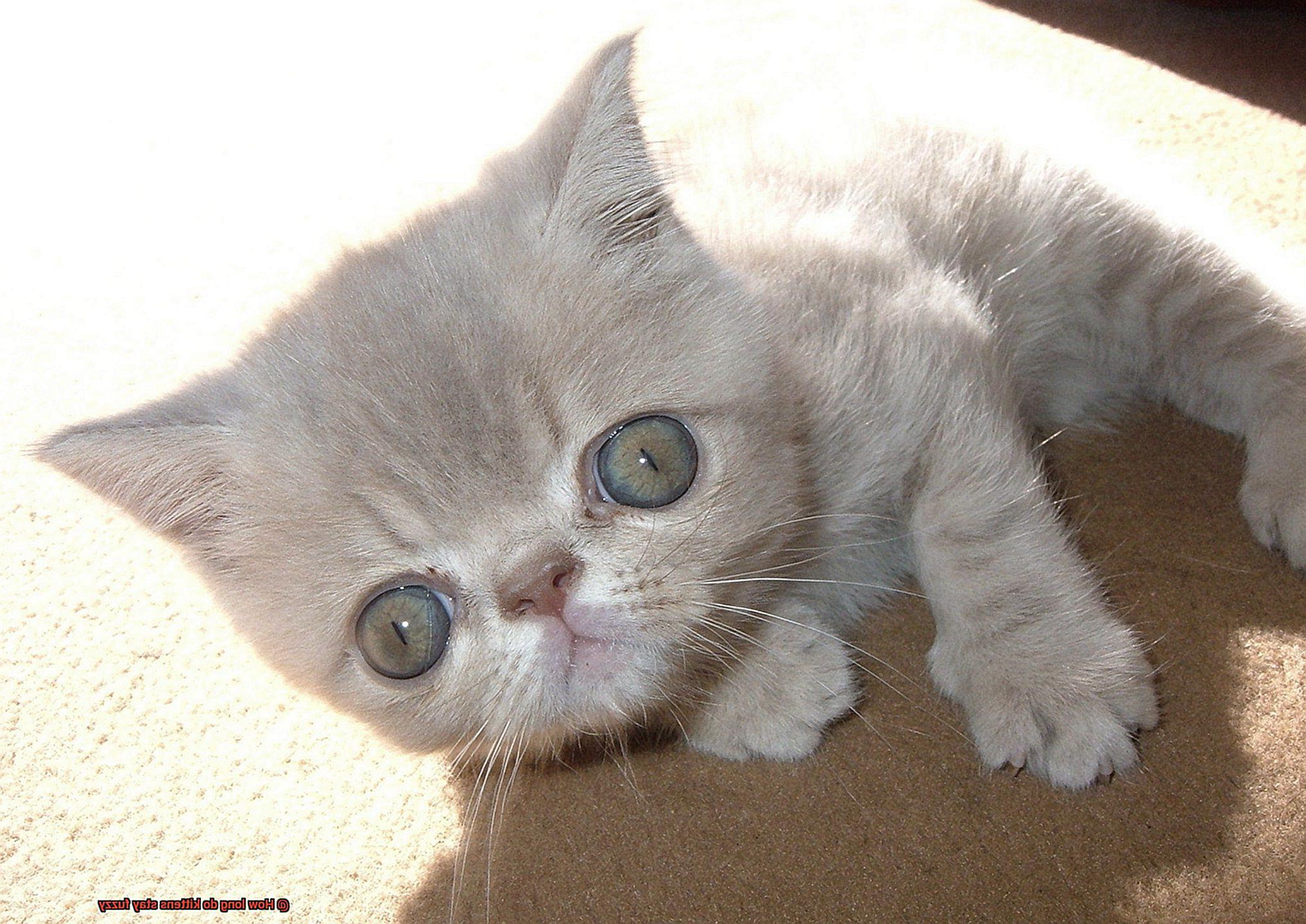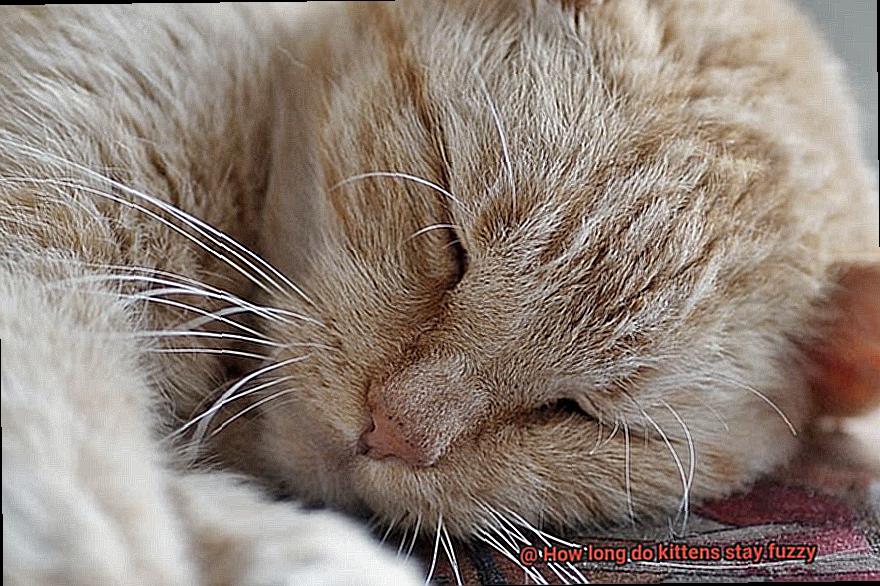Are you a sucker for adorable kittens with their super-soft and fluffy coats? Do you find yourself wondering how long those irresistible furballs stay fuzzy? If so, you’re in luck because we’ve got all the answers for you.
Let’s start by defining what we mean by “fuzzy.” We’re referring to that stage where a kitten’s baby fur is at its thickest and most plush, making them look like tiny balls of fluff. This stage usually lasts between 2 and 6 weeks before their adult fur starts to come in, and the fuzziness fades away.
However, keep in mind that this timeline can vary depending on your kitten’s breed and individual growth rate. But regardless of these factors, you can expect some serious cuteness overload during this fuzzy phase.
So, cherish every moment with your little ball of fluff while it lasts. Soon enough, they’ll start growing into their sleek and shiny adult selves. But for now, enjoy all the snuggles and cuddles that come with having a fuzzy little companion.
In conclusion, if you’re looking to adopt a kitten or have one already, savor every moment of their fuzzy stage as it won’t last forever. And who knows – maybe someday you’ll have another chance to experience the joy of a fuzzy little furball.
What is the Fuzzy Appearance of Kittens?
Kittens are the embodiment of cuteness, and their fuzzy appearance only adds to their irresistible charm. But what exactly is the fuzzy appearance of kittens, and how long does it last?
The fuzzy appearance of kittens refers to their soft, fluffy coat that helps keep them warm and cozy. This adorable feature is one of the many reasons why kittens are so beloved by cat enthusiasts worldwide.
At birth, kittens have a fine coat that is not very noticeable. However, as they grow older, their coat becomes thicker and more pronounced. This is when the fuzzy appearance of kittens starts to emerge, making them even more adorable than they already are.
While most kittens will lose their fuzziness between 4-6 months old as their adult coat grows in, some breeds may retain their fuzzy appearance for a significantly longer period. For example, Persian cats have long, luxurious fur that can remain fuzzy for up to a year due to their genetics and breeding history.
It’s worth noting that a cat’s coat can change throughout their life due to various factors such as diet, stress levels, and genetics. Therefore, regular grooming and proper nutrition are critical in ensuring your cat’s coat remains healthy and shiny throughout its lifespan.
How Long Does a Kitten Stay Fuzzy?
The truth is, there’s no one-size-fits-all answer to this question. Several factors play a role in determining the duration of your kitten’s fluffiness. Let’s explore some of these factors.
Firstly, breed plays a significant role in determining the length of a kitten’s fuzzy phase. Some breeds like Persians sport their thick and luxurious coats for up to a year due to their unique genetics and breeding history. Conversely, other breeds may have shorter hair that falls out more quickly.
Another essential factor is the kitten’s individual genetics. Just like humans, cats have their unique DNA that influences their physical characteristics and traits. Therefore, the duration of a kitten’s fuzziness may vary depending on their genetic makeup.
Besides, environmental factors like nutrition and stress can affect the duration of a kitten’s fluffy phase. A well-nourished and stress-free kitten is likely to maintain its fluffy coat for an extended period.
However, on average, most kittens start losing their baby fuzz at around three to four months of age. By six months, many will have shed most of their fluffy fur and will be sporting a sleek and shiny coat instead.
But regardless of how long your kitten remains fuzzy, proper grooming and care are crucial for their health and happiness. Regular brushing and grooming can help prevent matting and tangling of the fur while keeping shedding under control.

Factors That Affect a Kitten’s Fur Coats
Well, wonder no more. Understanding the factors that affect a kitten’s fur coats is key to keeping their coat healthy and looking its best.
The genetics of a kitten play a significant role in determining the length and thickness of their fur. Some breeds, like the majestic Persian cat, are known for having longer and thicker coats than others. However, even within a breed, there can be variations in fur length and texture.

Breed is another factor that can impact how long your kitten stays fuzzy. For instance, the Maine Coon has a longer growing period for their fur coats than other breeds. This means it may take longer for them to shed their baby fluff and grow into their adult coat.
Diet is also critical in promoting healthy hair growth and a shiny coat. A diet that lacks essential nutrients can cause dry, brittle fur that is more prone to shedding and matting. In contrast, a high-quality diet rich in protein, vitamins, and minerals can help promote healthy hair growth and a shiny coat.
Environmental conditions can also affect your kitten’s fur coat. Exposure to harsh weather conditions or pollutants can damage hair follicles and lead to shedding or breakage. It’s essential to provide your kitten with a safe and comfortable living environment to promote healthy fur growth.
As a responsible cat owner, you can help ensure your kitten has the healthiest coat possible by providing them with high-quality nutrition, regular grooming, and a safe living environment. Proper care can go a long way in ensuring they have a beautiful and healthy coat that will make every feline lover envious.
Shedding: What to Expect When Your Kitten Grows Up
Shedding is a natural process that occurs in all cats, including kittens. Understanding what to expect when your kitten grows up and providing proper grooming and care can help make the transition smoother for both you and your furry friend. Here are some key points to keep in mind:
Shedding Process in Kittens
As your kitten grows, their downy baby fur starts to be replaced by their adult coat. This process is known as shedding, and it usually begins around 12 weeks of age. The timing of this shedding can vary depending on the breed and individual growth patterns.
Timing of Shedding
Typically, kittens start shedding their baby fur around 3-4 months of age. As their adult fur grows in, the baby fur will fall out and be replaced by the longer, coarser adult fur. This process can take several months to complete, during which time you may notice an increase in shedding.

Proper Grooming
Regular grooming can help manage shedding and keep your kitten’s coat healthy and shiny. Brushing your kitten regularly can remove loose fur and prevent matting, which can lead to discomfort and skin irritation. Additionally, grooming provides a bonding opportunity with your kitten while also providing them with comfort and relaxation.

Healthy Diet

Providing your kitten with a healthy diet and plenty of hydration can promote healthy skin and coat. A diet rich in essential nutrients can support the growth of a healthy coat and reduce excessive shedding.
Signs of Health Issues
Excessive shedding or bald spots may be a sign of an underlying health issue or nutritional deficiency. If you notice these symptoms, it’s best to consult with your veterinarian to rule out any potential health concerns.
Different Breeds and Their Fuzziness Levels
Look no further. Different breeds have varying levels of fluffiness, and some are known for their luxurious, fluffy coats. Let’s dive into the world of cats and explore their unique features and qualities.
First up, we have the Persian cat, the epitome of luxury. This breed boasts long, thick fur that requires frequent grooming to maintain its beauty. A Persian can be a stunning addition to your home if you’re willing to put in the work.
On the other end of the spectrum, we have the Sphynx cat, a unique breed known for its lack of fur altogether. They may not be as fluffy as their counterparts, but don’t let that fool you; these felines are just as cuddly and lovable.
If you’re looking for a practical yet fuzzy companion, the Maine Coon might be the perfect fit. This breed has a thick and fluffy coat designed to keep them warm in colder climates. It takes up to three years for a Maine Coon kitten to fully develop its coat, so patience is key with this breed.
For those who want a low-maintenance cat without compromising on fuzziness, the American Shorthair is an ideal choice. Their dense coat requires minimal grooming, so you’ll have more time to spend snuggling with your furry friend.
Lastly, we have the Siamese cat known for their short and sleek coat. This breed requires less grooming than a long-haired breed, making them perfect for busy individuals who want the companionship of a feline friend without added maintenance.
It’s important to note that each breed has unique qualities beyond their fuzziness level. Some breeds like the Scottish Fold have a double coat that is both soft and dense, while others like the Devon Rex have curly and soft-to-the-touch shorter coats. The length and thickness of a kitten’s coat depend on their breed and genetics.
Grooming and Nutrition for Healthy Fur Coats
The key to maintaining a healthy and shiny fur coat for your kitten lies in two things: grooming and nutrition. Let’s explore these topics further.
Grooming is essential to remove loose fur, dirt, and debris from your kitten’s coat. It also stimulates blood flow to the skin, promoting healthy hair growth. Make it a daily habit to brush your kitten’s fur with a soft brush or comb. Not only will it make their fur look great, but it will also reduce the risk of matting and tangling.
Nutrition plays an equally important role in maintaining healthy fur coats. A well-balanced diet rich in high-quality protein and essential fatty acids is vital for healthy skin and hair growth. Omega-3 fatty acids found in fish oil or flaxseed oil can promote a shiny and healthy coat. So make sure your kitten gets the nutrients they need by feeding them a nutritious diet.

In addition to grooming and nutrition, regular vet visits are crucial for maintaining your kitten’s overall health, including their coat. Your vet can identify any underlying health issues that could be affecting your kitten’s coat and provide treatment if necessary.
To keep your kitten’s coat looking its best, here are some extra tips: always provide clean water to avoid dehydration that can lead to dry skin and a dull coat; avoid over-bathing your kitten as this can strip their skin of natural oils, causing dryness and irritation.
aEY_csYMglg” >
Conclusion
In conclusion, the soft and fluffy appearance of kittens is undoubtedly one of the reasons why they are universally adored by cat enthusiasts. However, the duration of their fuzzy phase can vary depending on a multitude of factors such as breed, individual growth rate, genetics, and environmental conditions like nutrition and stress levels.
Typically, most kittens start shedding their baby fuzz at around three to four months old. Shedding can continue for several more months until their adult coat fully develops. To ensure your kitten has a healthy and lustrous coat throughout its life, proper grooming and nutrition are crucial.
Regular brushing and grooming can help prevent matting and tangling of fur while keeping shedding under control. A well-balanced diet rich in high-quality protein and essential fatty acids is also vital for healthy skin and hair growth.
Different breeds have varying levels of fluffiness. Some require frequent grooming to maintain their luxurious coats while others like the Sphynx cat lack fur altogether but make up for it with their lovable personalities.







